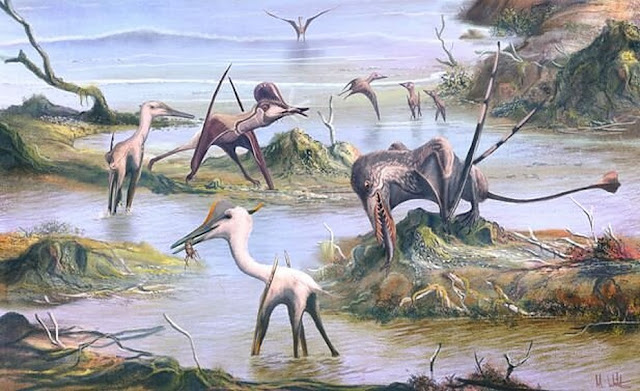Microscopic analysis of the teeth of pterosaurs has revealed new insights into the diets and behaviours of Earth's earliest flying reptiles.
 |
| Credit: University of Birmingham |
Researchers at the University of Leicester's Centre for Palaeobiology Research and the University of Birmingham used dental microwear analysis to look at the wear patterns still visible on the teeth of 17 different species of pterosaur. They compared these with similar patterns on the teeth of modern reptiles, including monitor lizards and crocodilians, where much more is known about their diet.
The team was able to show for the first time how the technique can be used to not only tell us what these animals ate, but also to challenge ideas about their lifestyles and evolution. Their results are published in Nature Communications.
"Most existing ideas about what pterosaurs ate come from comparisons of the shapes of their teeth with those of living animals," explains lead author Dr. Jordan Bestwick, of the University of Birmingham's School of Geography, Earth and Environmental Sciences. "For example, if the animal had conical teeth like a crocodile, we might assume it ate fish. But this approach has obvious shortcomings—the teeth of pandas and polar bears, for example, are similar, but comparing them wouldn't give us an accurate picture of their diets."
The analysis showed that modern reptiles with rougher wear on their tooth surfaces are more likely to have eaten crunchy things, such as shelled invertebrates—beetles or crabs—whereas reptiles which eat mainly soft items, such as fish, have smoother tooth surfaces. By applying the technique to pterosaurs the team was able to determine the diet of each species.
Dr. Bestwick says: "Our analysis has yielded some fascinating insights into individual species, but also into some of the bigger questions around how these pterosaurs evolved and whether their lifestyles were more similar to those of modern day birds or reptiles. Evidence from dental microwear analysis can shed new light on this debate."
Professor Mark Purnell, Professor of Palaeobiology at the University of Leicester said: "This is the first time this technique has been applied in this way to ancient reptiles, and it's great to find it works so well. Often, palaeontologists have very little to go on when trying to understand what extinct animals ate. This approach gives us a new tool, allowing us to move from what are sometimes little more than educated guesses, into the realms of solid science."
In one example, the team examined the teeth of Rhamphorhynchus, a long-tailed pterosaur from the Jurassic period. Researchers found that juvenile Rhamphorhynchus had insect-based diets, whereas their adult counterparts—about the size of a large seagull—were more likely to have eaten fish. This suggests a species in which the adults took little care of their young—a behaviour that is common in reptiles and is not exhibited by birds.
The team also investigated whether their analysis could shed light on how different species of pterosaurs evolved. Pterosaurs lived between 210 and 66 million years ago, eventually dying out at the same time as dinosaurs. In that time, according to the dental microwear analysis, there was a general shift in diet from invertebrates such as insects, towards a more meat or fish-based diet.
"We found that the earliest forms of pterosaurs ate mainly crunchy invertebrates," says Dr. Bestwick. "The shift towards eating fish or meat coincides with the evolution of birds. We think it's possible, therefore, that competition with birds could explain the decline of smaller-bodied pterosaurs and a rise in larger, carnivorous species."
Natalia Jagielska, a Ph.D. researcher in pterosaur palaeontology at the University of Edinburgh, (not involved in this study) says the research adds much-needed clarity to the behaviour and ecological role of pterosaurs in ancient food webs.
"Pterosaurs are a fascinating group of Mesozoic reptiles with astounding diversity in tooth morphology," she says. "This study is important for contributing to the idea that young Rhamphorhynchus were independent invertebrate hunters before becoming fish consumers, rather than being fed and nurtured by parents, like birds. Or that in pterosaur-rich environments, like the Late Jurassic Bavarian lagoons, pterosaur species have partitioned to occupy variations of dietary niches."
The research team anticipate their methods will set a new benchmark for robust interpretation of extinct reptile diets, paving the way for an enhanced understanding of ancient ecosystems.
Source: University of Birmingham [October 29, 2020]
No comments:
Post a Comment